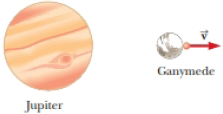
Concept explainers
Ganymede is the largest of Jupiter’s moons. Consider a rocket on the surface of Ganymede, at the point farthest from the planet (Fig. P13.23). Model the rocket as a particle. (a) Does the presence of Ganymede make Jupiter exert a larger, smaller, or same size force on the rocket compared with the force it would exert if Ganymede were not interposed? (b) Determine the escape speed for the rocket from the planet–satellite system. The radius of Ganymede is 2.64 × 106 m, and its mass is 1.495 × 1023 kg. The distance between Jupiter and Ganymede is 1.071 × 109 m, and the mass of Jupiter is 1.90 × 1027 kg. Ignore the motion of Jupiter and Ganymede as they revolve about their center of mass.
Figure P13.23

Trending nowThis is a popular solution!

Chapter 13 Solutions
Physics for Scientists and Engineers
Additional Science Textbook Solutions
General, Organic, and Biological Chemistry - 4th edition
Genetics: Analysis and Principles
Campbell Biology: Concepts & Connections (9th Edition)
Fundamentals of Physics Extended
Cosmic Perspective Fundamentals
- Please solve and answer the problem correctly please.Thank you!!arrow_forwardProblem Eight. A snowmobile is originally at the point with position vector 31.1 m at 95.5° counterclockwise from the x-axis, moving with velocity 4.89 m/s at 40.0°. It moves with constant acceleration 1.73 m/s² at 200°. After 5.00 s have elapsed, find the following. 9.) The velocity vector in m/s. (A)=-4.38+0.185ĵ (D) = 0.185 +4.38ĵ (B)=0.1851-4.38ĵ (E) = 4.38 +0.185ĵ (C) v=-0.1851-4.38ĵ (A)=-39.3-4.30ĵ 10.) The final position vector in meters. (B)=39.3-4.30ĵ (C) = -4.61 +39.3ĵ (D) = 39.31 +4.30ĵ (E) = 4.30 +39.3ĵarrow_forwardProblem Seven. A football receiver running straight downfield at 5.60 m/s is 11.5 m in front of the quarterback when a pass is thrown downfield at an angle of 35.0° above the horizon. 8.) If the receiver never changes speed and the ball is caught at the same height from which it was thrown, find the distance between the quarterback and the receiver when the catch is made. (A) 21.3 (B) 17.8 (C) 18.8 (D) 19.9 (E) 67.5arrow_forward
- 3 Consider a ball sliding down a ramp as shown above. The ball is already in motion at the position 1. Which direction best approximates the direction of instantaneous velocity vector V when the object is at position 3?arrow_forwardNo chatgpt plsarrow_forwardA car in a roller coaster moves along a track that consists of a sequence of ups and downs. Let the x axis be parallel to the ground and the positive y axis point upward. In the time interval from t 0 tot = = 4s, the trajectory of the car along a certain section of the track is given by 7 = A(1 m/s)ti + A [(1 m/s³) t³ - 6(1 m/s²)t²]ĵ where A is a positive dimensionless constant. At t car ascending or descending? = 2.0 S is the roller coaster Ascending. Descending.arrow_forward
 Principles of Physics: A Calculus-Based TextPhysicsISBN:9781133104261Author:Raymond A. Serway, John W. JewettPublisher:Cengage Learning
Principles of Physics: A Calculus-Based TextPhysicsISBN:9781133104261Author:Raymond A. Serway, John W. JewettPublisher:Cengage Learning University Physics Volume 1PhysicsISBN:9781938168277Author:William Moebs, Samuel J. Ling, Jeff SannyPublisher:OpenStax - Rice University
University Physics Volume 1PhysicsISBN:9781938168277Author:William Moebs, Samuel J. Ling, Jeff SannyPublisher:OpenStax - Rice University Physics for Scientists and Engineers: Foundations...PhysicsISBN:9781133939146Author:Katz, Debora M.Publisher:Cengage Learning
Physics for Scientists and Engineers: Foundations...PhysicsISBN:9781133939146Author:Katz, Debora M.Publisher:Cengage Learning Stars and GalaxiesPhysicsISBN:9781305120785Author:Michael A. Seeds, Dana BackmanPublisher:Cengage Learning
Stars and GalaxiesPhysicsISBN:9781305120785Author:Michael A. Seeds, Dana BackmanPublisher:Cengage Learning Classical Dynamics of Particles and SystemsPhysicsISBN:9780534408961Author:Stephen T. Thornton, Jerry B. MarionPublisher:Cengage Learning
Classical Dynamics of Particles and SystemsPhysicsISBN:9780534408961Author:Stephen T. Thornton, Jerry B. MarionPublisher:Cengage Learning Foundations of Astronomy (MindTap Course List)PhysicsISBN:9781337399920Author:Michael A. Seeds, Dana BackmanPublisher:Cengage Learning
Foundations of Astronomy (MindTap Course List)PhysicsISBN:9781337399920Author:Michael A. Seeds, Dana BackmanPublisher:Cengage Learning





